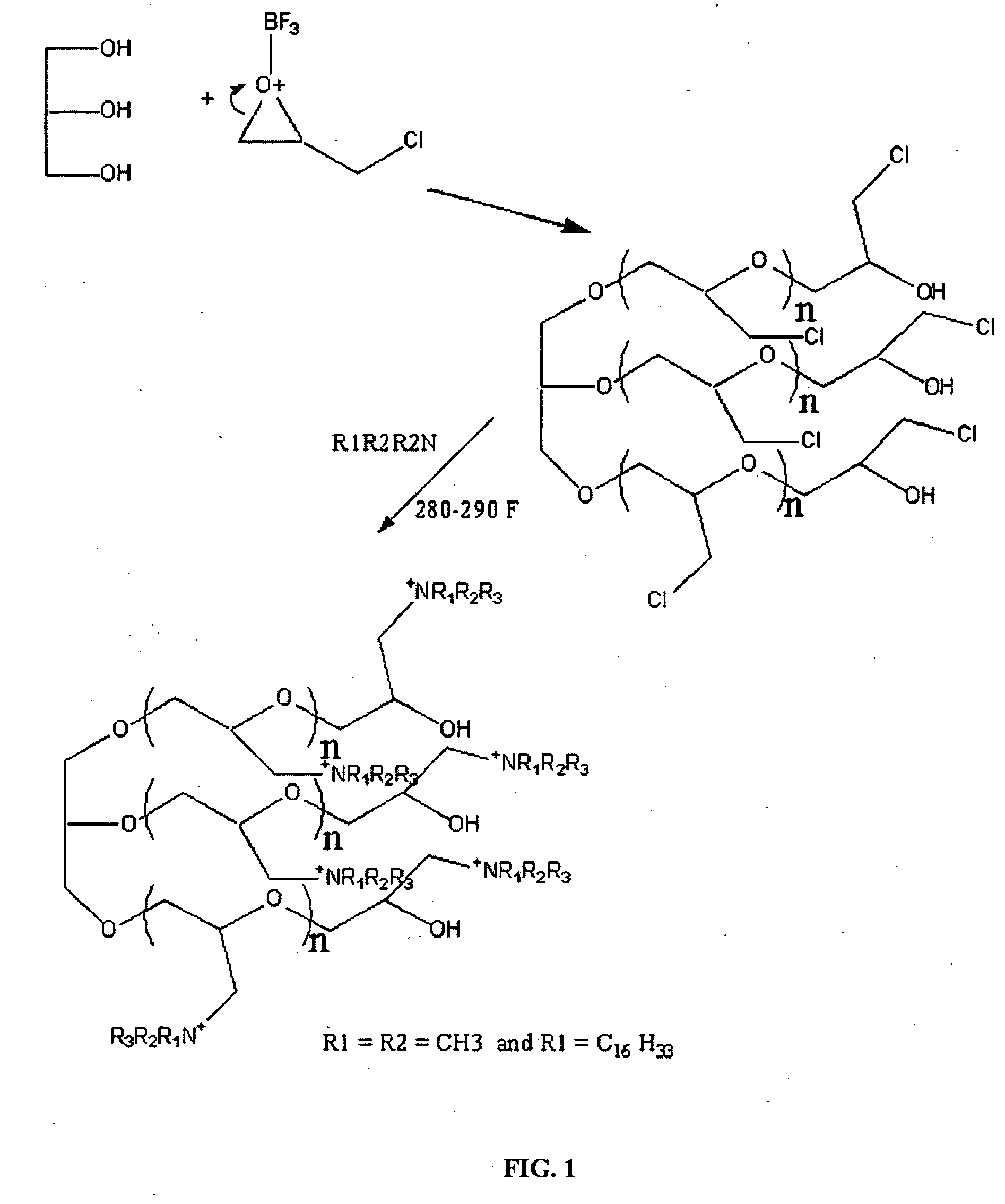Polymeric quaternary ammonium salts useful as corrosion inhibitors and biocides
a technology of polyquaternary ammonium salts and biocides, which is applied in the field of corrosion inhibitors, can solve the problems of corroding the metallic flow line of petroleum products containing brine, and achieve the effect of reducing the corrosion of the produ
- Summary
- Abstract
- Description
- Claims
- Application Information
AI Technical Summary
Benefits of technology
Problems solved by technology
Method used
Image
Examples
example 1
[0038] This example synthesized the polymeric quaternary ammonium salts from hexadecyl dimethyl amine. First, glycerin-epichlorohydrin polymer was prepared by placing 1.0 mole of glycerin and a catalytic amount of boron trifluoride etherate into a four-necked flask that was fitted with a condenser, a nitrogen sparge tube, a stirrer and a thermometer. Epichlorohydrin (15.0 mol, 1387 g) was placed in an adding funnel.
[0039] The flask was heated 160° F. while adding the epichlorohydrin from the funnel. Epichlorohydrin was added drop-wise and the temperature was maintained between about 165° F. and about 180° F. After all the epichlorohydrin was added, the mixture was stirred for one hour at 165° F.
[0040] The glycerin-epichlorohydrin polymer (95 g) was added to a kettle containing 100 mL of ethylene glycol monobutyl ether. The polymer was heated to about 220° F. and then 1 mole (267 g) of hexadecyl dimethyl amine was added to the kettle. The mixture was then heated and maintained at a...
example 2
[0042] This example synthesized the polymeric quaternary ammonium salts from tetradecyl dimethyl amine. First, glycerin-epichlorohydrin polymer was prepared as described in Example 1. The polymer (92 g) was added to a kettle containing 100 mL of ethylene glycol monobutyl ether. The polymer was heated to about 220° F. and then 1 mole (239 g) of tetradecyl dimethyl amine was added to the kettle. The mixture was then heated and maintained at a temperature between 270° F. and 280° F. for 17 hours to yield the polymeric quaternary ammonium salt product.
[0043] The total amine value of the chemical is a good indicator for the completion of the reaction. The total amine value was less than 0.1%.
example 3
[0044] This example synthesized the polymeric quaternary ammonium salts from dodecyl dimethyl amine. First, glycerin-epichlorohydrin polymer was prepared as described in Example 1. The polymer (92 g) was added to a kettle containing 100 mL of ethylene glycol monobutyl ether. The polymer was heated to about 220° F. and then 1 mole (221 g) of dodecyl dimethyl amine was added to the kettle. The mixture was then heated and maintained at a temperature between 270° F. and 280° F. for 17 hours to yield the polymeric quaternary ammonium salt product.
[0045] The total amine value of the chemical is a good indicator for the completion of the reaction. The total amine value was less than 0.1%.
PUM
| Property | Measurement | Unit |
|---|---|---|
| Fraction | aaaaa | aaaaa |
| Fraction | aaaaa | aaaaa |
| Fraction | aaaaa | aaaaa |
Abstract
Description
Claims
Application Information
 Login to View More
Login to View More - R&D
- Intellectual Property
- Life Sciences
- Materials
- Tech Scout
- Unparalleled Data Quality
- Higher Quality Content
- 60% Fewer Hallucinations
Browse by: Latest US Patents, China's latest patents, Technical Efficacy Thesaurus, Application Domain, Technology Topic, Popular Technical Reports.
© 2025 PatSnap. All rights reserved.Legal|Privacy policy|Modern Slavery Act Transparency Statement|Sitemap|About US| Contact US: help@patsnap.com



